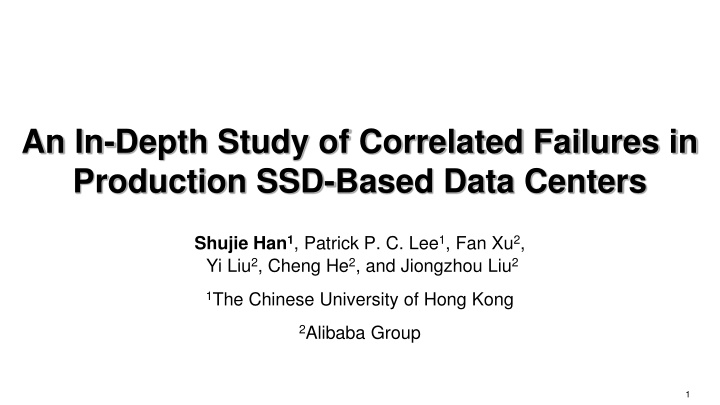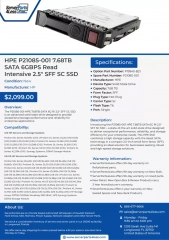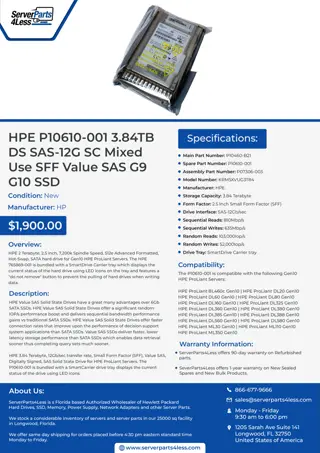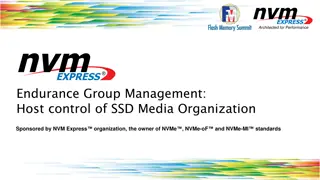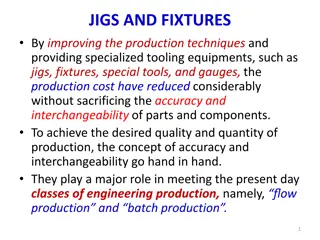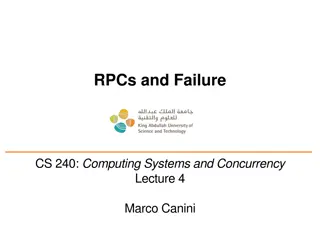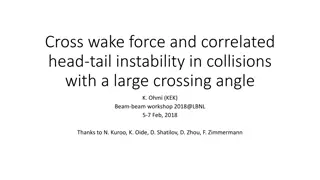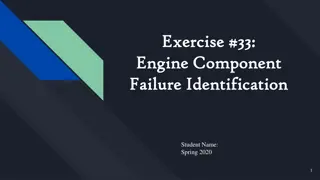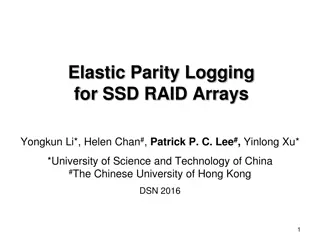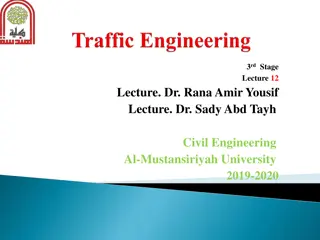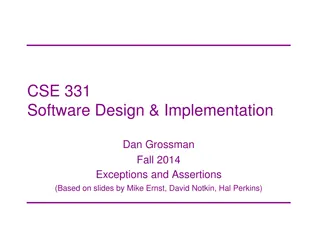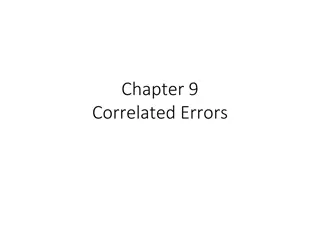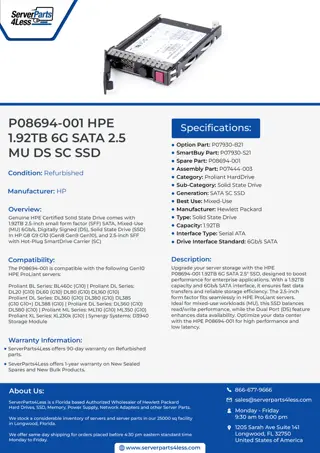Correlated Failures in Production SSD-Based Data Centers
This study delves into the characteristics and implications of correlated failures in solid-state drives (SSDs) in modern data centers. It provides insights from spatial and temporal perspectives, analyzing intra-node and intra-rack failures, and their impact on storage reliability. The research includes findings on drive characteristics, SMART attributes, and applications, along with a trace-driven simulation on redundancy scheme reliability under correlated failures. The dataset gathered spans two years and includes SMART logs, trouble tickets, locations, and applications of nearly 1 million SSDs from various vendors.
Download Presentation

Please find below an Image/Link to download the presentation.
The content on the website is provided AS IS for your information and personal use only. It may not be sold, licensed, or shared on other websites without obtaining consent from the author.If you encounter any issues during the download, it is possible that the publisher has removed the file from their server.
You are allowed to download the files provided on this website for personal or commercial use, subject to the condition that they are used lawfully. All files are the property of their respective owners.
The content on the website is provided AS IS for your information and personal use only. It may not be sold, licensed, or shared on other websites without obtaining consent from the author.
E N D
Presentation Transcript
An In-Depth Study of Correlated Failures in Production SSD-Based Data Centers Shujie Han1, Patrick P. C. Lee1, Fan Xu2, Yi Liu2, Cheng He2, and Jiongzhou Liu2 1The Chinese University of Hong Kong 2Alibaba Group 1
Motivation Correlated failures Challenge high storage reliability Complicate design of redundancy protection schemes Solid-state drives (SSDs) become the mainstream storage media in modern data centers What are the characteristics of correlated failures of SSDs? What are implications of correlated failures of SSDs on storage reliability in production environments? 2
Our Contribution An in-depth data-driven analysis on correlated failures of SSDs from spatial and temporal perspectives We provide 15 findings on correlated failures Intra-node and intra-rack failures Impact of drive characteristics, SMART attributes, and applications Trace-driven simulation on reliability of redundancy schemes under correlated failures We release our dataset and source code for public use 3
Dataset Collect nearly 1 million SSDs of 11 drive models from 3 vendors over two-year span (Jan. 2018 Dec. 2019) at Alibaba Data types: SMART logs, trouble tickets, locations (e.g., nodes and racks), and applications Two main types of SSD failures in trouble tickets: Whole drive failures: an SSD either cannot be accessed or loses all data that is unrecoverable Partial drive failure: part of the data in an SSD either cannot be accessed and is unrecoverable 4
Analysis Methodology Spatial and temporal properties Intra-node (intra-rack) failures: failures co-occurring within a node (rack) Intra-node (intra-rack) failure time interval: 30 minutes by default Intra-node (intra-rack) failure group: a sequence of intra-node (intra-rack) failures Correlation properties Spearman s Rank Correlation Coefficient (SRCC) Measure correlations between correlated failures and SMART attributes 5
Correlations Among Failures Finding 1: A non-negligible fraction of SSD failures belong to intra-node and intra-rack failures 12.9% (18.3%) of failures are intra-node (intra-rack) failures Intra-node (intra-rack) failure group size can exceed the tolerable limit of some redundancy protection schemes 6
Correlations Among Failures Finding 2: Likelihood of having an additional intra-node (intra- rack) failure depends on existing intra-node (intra-rack) failures Finding 3: A non-negligible fraction of intra-node and intra-rack failures occur within a short period of time, even within one minute 7
Impact of Drive Models Finding 4: Relative percentages of intra-node (intra-rack) failures vary across drive models Putting too many SSDs from the same drive model in the same nodes (racks) leads to a high percentage of intra-node (intra-rack) failures AFR and environmental factors (e.g., temperature) 8
Impact of Drive Models Finding 5: Non-negligible fractions of intra-node and intra-rack failures with a short failure time interval (e.g., one minute) for most drive models 3.5-33.4% (7.8-37.1%) of intra-node (intra-rack) failures except A4 and C2 (C2) 9
Impact of Lithography Finding 6: MLC SSDs with higher densities generally have lower relative percentages of intra-node and intra-rack failures For MLC SSDs, a smaller lithography implies a higher density 3D-TLC SSDs have higher densities than those of MLC SSDs 10
Impact of Age Finding 7: Relative percentages of intra-node and intra-rack failures increase with age Intra-node and intra-rack failures at an older age are more likely to occur within a short time due to the increasing rated life used 11
Impact of Capacity Finding 8: Relative percentages of intra-node and intra-rack failures vary significantly across the capacity No clear trend between relative percentages of intra-node (or intra-rack) failures for different thresholds of failure time intervals and capacity 12
Impact of SMART Attributes Finding 9: SMART attributes have limited correlations with intra- node and intra-rack failures The highest SRCC values (from S187) are only 0.23 for both intra-node and intra-rack failures SMART attributes are not good indicators for detecting the existence of intra-node and intra-rack failures Intra-node and intra-rack failures have no significant difference of absolute values of SRCC for each SMART attribute 13
Impact of Applications Finding 10: Write-dominant workloads lead to more SSD failures overall, but are not the only factors on AFRs Other factors, such as drive models, can affect AFRs 14
Impact of Applications Finding 11: Applications with more SSDs per node (rack) and write-dominant workloads tend to have a high percentage of intra- node (intra-rack) failures 15
Impact of Applications Finding 12: For the applications, intra-node and intra-rack failures at an older age and with more write-dominant workloads tend to occur in a short time 16
Case Study: Redundancy Protection Redundancy schemes r-way replication (Rep(r)): Rep(2) and Rep(3) Reed-Solomon coding (RS(k, m)): RS(6,3), RS(10,4), and RS(12,4) Local Reconstruction Coding (LRC(k, l, g)): LRC(12,2,2) Eager recovery vs. lazy recovery Simulator Extend C++ discrete-event simulator SimEDC[TPDS 19 Zhang] Metrics Probability of data loss (PDL) Normalized magnitude of data loss (NOMDL) 17
Simulation Results Finding 13: Erasure coding shows higher reliability than replication based on failure patterns in our dataset Finding 14: Redundancy schemes that are sufficient for tolerating independent failures may be insufficient for correlated failures 18
Simulation Results Finding 15: Lazy recovery is less suitable than eager recovery for tolerating correlated failures in our dataset Eager recovery: a threshold of one High reliability under only independent failures Degrading reliability under correlated failures as the threshold increases 19
Conclusion We report 15 findings on correlated failures of SSDs based on large-scale dataset at Alibaba Spatial and temporal correlations of SSD failures Impact of different factors on correlated failures Trace-driven simulation on reliability of various redundancy schemes under correlated failures Dataset and source code: https://github.com/alibaba-edu/dcbrain/tree/master/ssd_open_data http://adslab.cse.cuhk.edu.hk/software/ssdanalysis 20
Thank You! Q & A 21
